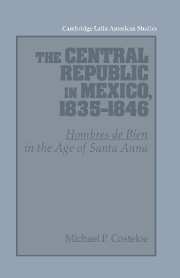Book contents
- Frontmatter
- Contents
- Preface
- Acknowledgements
- 1 An introduction: change and continuity in the Age of Santa Anna
- 2 The end of federalism
- 3 The transition to centralism: stage I
- 4 The transition to centralism: stage II
- 5 Las Siete Leyes
- 6 Anastasio Bustamante and the centralist republic, 1837–1839
- 7 Santa Anna versus Bustamante: the end of the Siete Leyes, 1839–1841
- 8 ‘La dictadura disfrazada con el hermoso nombre de regeneración política’
- 9 Santa Anna and the Bases Orgánicas
- 10 ‘La revolución de tres horas’
- 11 Herrera and the rise of Paredes y Arrillaga
- 12 Hombres de bien and the restoration of federalism
- 13 Conclusion
- Sources and works cited
- Index
- CAMBRIDGE LATIN AMERICAN STUDIES
1 - An introduction: change and continuity in the Age of Santa Anna
Published online by Cambridge University Press: 23 October 2009
- Frontmatter
- Contents
- Preface
- Acknowledgements
- 1 An introduction: change and continuity in the Age of Santa Anna
- 2 The end of federalism
- 3 The transition to centralism: stage I
- 4 The transition to centralism: stage II
- 5 Las Siete Leyes
- 6 Anastasio Bustamante and the centralist republic, 1837–1839
- 7 Santa Anna versus Bustamante: the end of the Siete Leyes, 1839–1841
- 8 ‘La dictadura disfrazada con el hermoso nombre de regeneración política’
- 9 Santa Anna and the Bases Orgánicas
- 10 ‘La revolución de tres horas’
- 11 Herrera and the rise of Paredes y Arrillaga
- 12 Hombres de bien and the restoration of federalism
- 13 Conclusion
- Sources and works cited
- Index
- CAMBRIDGE LATIN AMERICAN STUDIES
Summary
Over the past forty years, impressive progress has been made in our knowledge of the history of Mexico; historians on both sides of the Atlantic have written many important books and articles which have cast new light on the way the country has developed. Looking at the broad sweep of Mexican historiography from the sixteenth to the twentieth century, it is evident that the colonial era and the 1910 Revolution and its aftermath have found most favour. Since the seminal work of Tannenbaum and his generation, the Revolution in particular has been subjected to intense scrutiny. There have been many studies of major and minor personalities and dozens of well-researched investigations into political, social, economic and cultural aspects. Almost a whole generation's work culminated in 1986 with the publication of Knight's monumental two-volume work, more than one thousand pages long, which brought together and analysed, supported or rejected, the myriad interpretations of one of the major events of the twentieth century.
The colonial period has been equally well, if not even better, served. Borah, Gibson, Hanke and others in the United States, Zavala and Miranda in Mexico, Chevalier and Ricard in France, to name only a few, examined early colonial institutions, society and religious life with unprecedented skill and attention.
- Type
- Chapter
- Information
- The Central Republic in Mexico, 1835–1846'Hombres de Bien' in the Age of Santa Anna, pp. 1 - 30Publisher: Cambridge University PressPrint publication year: 1993



